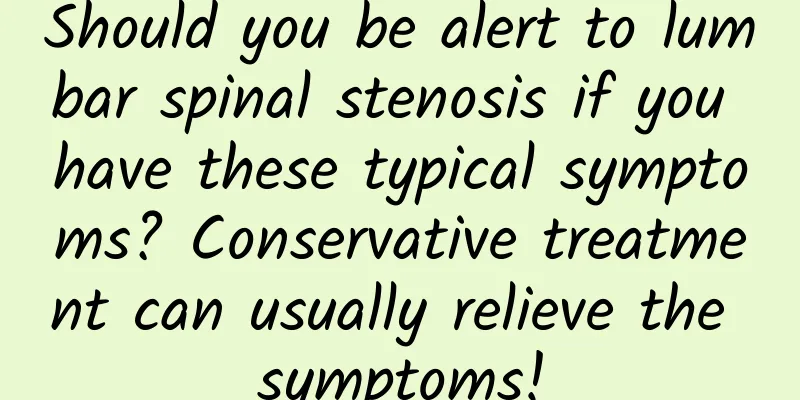Should you be alert to lumbar spinal stenosis if you have these typical symptoms? Conservative treatment can usually relieve the symptoms!

|
Author: Zhang Zhaojie, Chief Physician, Wangjing Hospital, China Academy of Chinese Medical Sciences Reviewer: Zhang Zhihai, Chief Physician, Guang'anmen Hospital, China Academy of Chinese Medical Sciences The spine is composed of vertebrae, each with a vertebral foramen in the middle. The vertebral foramen connecting the cervical, thoracic, and lumbar vertebrae is called the spinal canal. The lumbar spinal canal is a tube composed of the vertebral foramina of the lumbar vertebrae, which contains the dura mater sac and cauda equina, and is the channel for the lumbar nerves to pass through. Figure 1 Original copyright image, no permission to reprint Due to some factors, the lumbar spinal canal is narrowed, and the nerves are compressed in the process of moving inside, causing corresponding symptoms, which is called lumbar spinal stenosis. According to the different locations of stenosis, it is divided into central canal stenosis, lateral recess stenosis, and intervertebral foraminal stenosis. Different locations of stenosis cause different symptoms. The main cause of lumbar spinal stenosis is degeneration, also known as aging. With age, or long-term bad posture, the spine degenerates, causing hypertrophy of the yellow ligament or hyperplasia of small joints, leading to spinal stenosis. With age, the joints become unstable or loose, and the vertebrae become unstable. In more serious cases, lumbar spondylolisthesis may occur. After two vertebrae slip, they will compress the nerves in the spinal canal. Another cause is a lumbar fracture caused by trauma. After the fracture, there is no timely surgical treatment, no spinal canal decompression, and only treatment for the fracture. After the fracture heals, spinal stenosis is likely to occur in the later stage. Figure 2 Original copyright image, no permission to reprint The typical symptom of lumbar spinal stenosis is low back pain accompanied by lower limb pain. After walking for a while, you can't walk because of leg pain and numbness. Your legs will be a little lame. You can walk again after sitting down and resting for a while. This is called intermittent claudication. Severe lumbar spinal stenosis may cause nerve damage, numbness of the lower limbs, weakness and other neurological symptoms. Lumbar spinal stenosis causes intermittent claudication, which is mainly related to the pathogenesis. The channel for nerves is narrowed. There are some arteries and veins around the nerves, and there is venous return. When walking, blood circulation will speed up. Spinal stenosis will hinder the venous return around the nerves, which will cause swelling around the nerves. The spinal canal is narrow, and the swelling around it will compress the nerves, causing swelling and numbness in the lower limbs. In order to relieve the pain, sit down or squat to rest for a while. After the volume of the spinal canal changes, the blood will flow smoothly. After resting for 5-10 minutes, you can continue walking. The main cause of lumbar spinal stenosis is degeneration. With age, continuous and multi-segmental spinal stenosis will occur. Multi-segmental lumbar spinal stenosis may cause soreness, pain and discomfort in the entire leg. If you experience back pain, leg pain, and typical intermittent claudication in daily life, it is recommended to go to the hospital for examination and do a lumbar CT or MRI. CT can see the location and degree of stenosis, and can distinguish whether it is a hard stenosis caused by bone hyperplasia or a soft stenosis caused by hypertrophy of the yellow ligament. Magnetic resonance imaging can clearly locate the segment of lumbar spinal stenosis. Once lumbar spinal stenosis is diagnosed, precise treatment should be carried out as soon as possible. First, conservative treatment can be used, such as using external Chinese medicine, oral Chinese medicine, acupuncture and other methods to improve the local Qi and blood in the waist, relax the muscles and activate the collaterals, and improve the inflammatory response caused by the compression of the lumbar nerves, and the symptoms will also improve. Conservative treatment does not open the narrow lumbar spinal canal, but improves the inflammatory response of the nerves and surrounding muscles. About 70% of patients will have their symptoms relieved after conservative treatment. If the symptoms do not improve after conservative treatment, the walking distance becomes shorter and shorter, and the lower limbs become weak and walking becomes difficult, this indicates that the nerves are damaged and conservative treatment is not suitable. Surgery is required. If the stenosis occurs in a single segment, minimally invasive surgery can be used to decompress and release the nerves locally to achieve the treatment goal. If the stenosis occurs in multiple segments and the bone stenosis is very serious, open surgery may be required, which can achieve the purpose of radical cure. |
>>: Difficulty breathing, how to give first aid correctly? Experts explain four situations
Recommend
What was the ancient administrative agency of Tibet called? What documents do people from Xinjiang need to go to Tibet?
Tibet is located in a remote area of my country...
What is multiple uterine cysts?
The uterus is an important organ that causes mens...
How long does it take for the belly to be visible during pregnancy?
After a woman becomes pregnant, the development o...
Can myopia and presbyopia be offset? Let's see what the ophthalmologist says!
“People with myopia will not get presbyopia!” &qu...
Pregnant woman lived in a formaldehyde room for 5 days
Inhaling too much indoor formaldehyde can cause v...
What should pregnant women eat when they are weak and sweat a lot?
In fact, many women will experience physical weak...
What causes breast pain in women? How to diagnose it?
Women's bodies are very fragile, and they are...
My stomach hurts like a needle prick. My stomach hurts like a needle prick.
Pregnancy is an ability that women are born with....
National Science Popularization Day | Milk traffic lights, entrance options
Milk is rich in nutrients, has a suitable composi...
Can insufficient ovarian reserve be restored?
The ovaries are important reproductive organs of ...
30-day recipe for induced labor and confinement meals
After induced abortion, women will be very weak. ...
Can kidney deficiency in women be cured?
Generally speaking, kidney deficiency is associat...
My period is over but I am bleeding again after sex
There is also bleeding after menarche, which is n...
What causes knee pain in young women at night?
The importance of knees to us is self-evident, es...
Female genital hair removal methods
With the rapid development of life nowadays, many...









